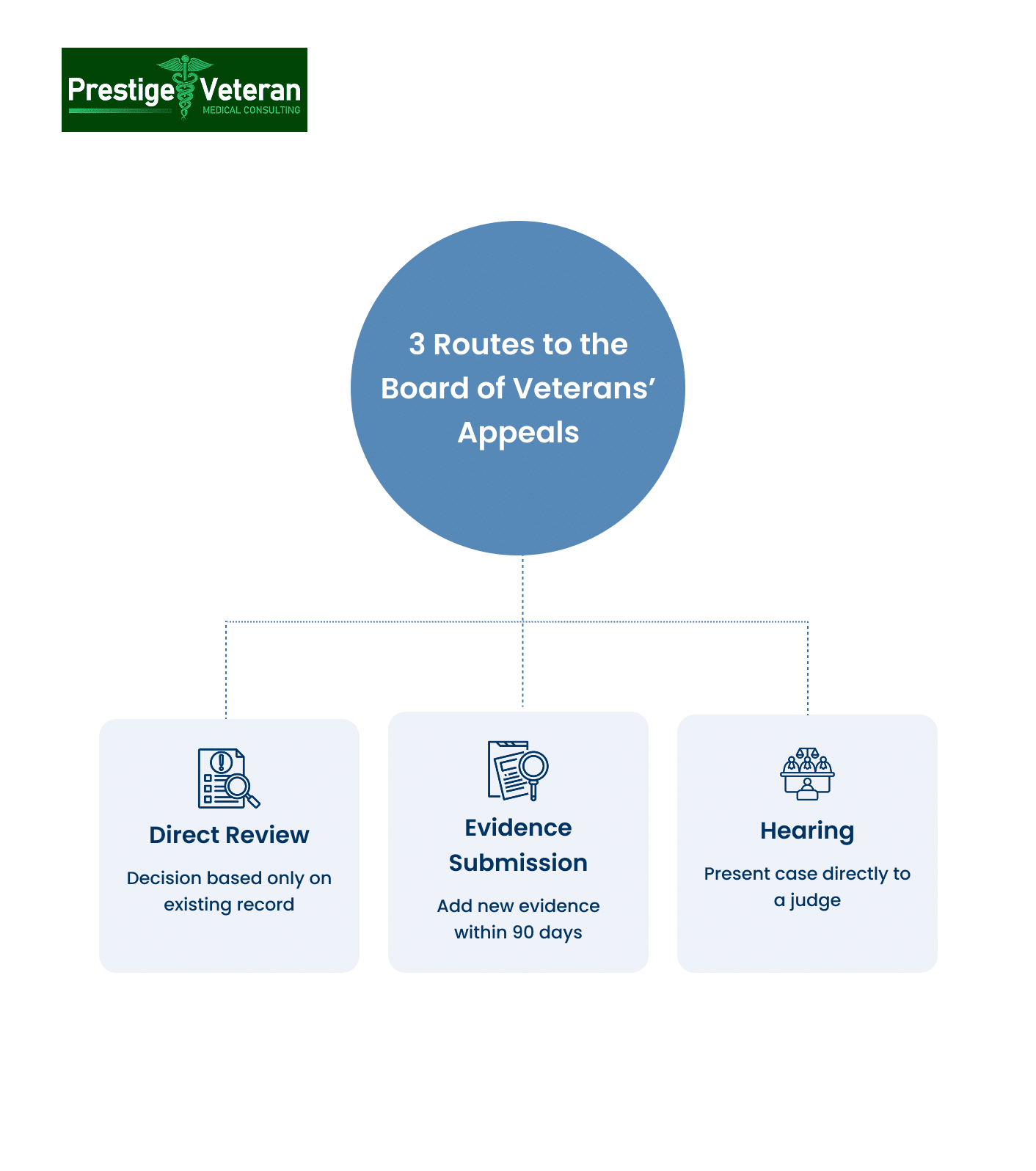Last Updated on 3 September, 2025
Navigating the complex world of Veterans Affairs (VA) disability claims can be overwhelming for many veterans. Accredited Claims Agent Garren Cone sheds light on the intricacies of VA appeals to the Board of Veterans Appeals (BVA). This article aims to provide a comprehensive overview of the BVA appeal process, discussing how veterans can pursue it either independently or with the assistance of an accredited legal professional.

Table of Contents
What Is the Board of Veterans’ Appeals for Veterans?
Established on July 28, 1933, by President Franklin D. Roosevelt, the Board of Veterans’ Appeals or BVA is an administrative body within the Department of Veterans Affairs (VA). Located in Washington, D.C., the BVA serves as the highest level of appellate review within the VA system before a case can be positioned to the U.S. Court of Appeals for Veterans Claims.
When opting for a BVA appeal, veterans receive a docket number indicating that their case is ready for review. At this point, veterans must decide whether they want to submit their case as is, without adding any new evidence, or if they want to present additional information.
The BVA exists to ensure that veterans, their dependents, and survivors receive fair and impartial review of their claims when disagreements arise with the VA’s regional decisions.
BVA Meaning & Jurisdiction
- BVA Meaning: Board of Veterans’ Appeals
- Jurisdiction: Reviews all questions of law and fact related to VA benefits decisions, including disability compensation, health care, education, pension, insurance, and burial benefits.
- Authority: Functions on behalf of the Secretary of Veterans Affairs under 38 U.S. Code § 7101-7113.
When a Veterans Affairs appeal board receives a case, it’s placed into one of three review tracks based on the type of appeal requested under the Appeals Modernization Act (AMA). The other two options include a higher-level review and a supplemental claim.
The VA Board of Appeals resolved a record 116,192 appeals in Fiscal Year 2024.
Who Makes BVA Decisions?
BVA decisions are made exclusively by Veterans Law Judges (VLJs), attorneys appointed by the Secretary of Veterans Affairs, with final approval from the President of the United States. Each of these judges has extensive training and experience in veterans law.
The Board’s structure includes:
- Chairman (Presidential appointment)
- Vice Chairman
- Deputy Vice Chairmen
- Over 100 Veterans Law Judges
- 800+ attorney-advisors and support staff
Only a Veterans Law Judge can issue BVA decisions, making them the final authority within the VA system.
When Can You Appeal to the BVA?
Veterans can appeal to the Board of Veterans Appeals when they disagree with a decision issued by the VA regional office on any benefits-related claim. Under the Appeals Modernization Act (AMA) of 2019, the Board of Veterans’ Appeals serves as the next level of review following:
- A denied initial claim
- An unsuccessful Supplemental Claim
- An unsatisfactory Higher-Level Review decision
Per the Appeals Modernization Act (AMA), the official process begins when a veteran files a Notice of Disagreement within 1 year of the VA decision letter date. Veterans cannot appeal the same issue multiple times unless new evidence or a legal basis arises.
Exceptions include contested claims (e.g., spousal disputes) that require appeals within 60 days.
Three Types of BVA Appeal Options (AMA System)

Under the Appeals Modernization Act (AMA), veterans can choose from three structured options when filing a Board of Veterans’ Appeals (BVA) appeal. Each docket is designed to align with the veteran’s needs and the type of evidence available.
1. Direct Review Docket
This option involves no hearing and does not allow new evidence. The Veterans Law Judge makes a decision based solely on the existing record. It’s ideal for veterans who believe the VA misapplied the law or missed critical evidence already submitted. The target timeline is 365 days, although real-world wait times average around 866 days.
Ideal for: Veterans confident that the VA misapplied the law or overlooked existing evidence.
2. Evidence Submission Docket
In this BVA option, veterans can submit new and relevant evidence within 90 days of filing the appeal but do not attend a hearing. It’s a good choice when new medical records, service treatment records, or expert nexus letters become available after the initial decision. Average decision time is approximately 1,056 days.
Ideal for: Veterans who discovered new and relevant medical records or service documents post-decision.
3. Hearing Docket
This option includes a formal hearing before a Veterans Law Judge, either in-person, virtual, or by videoconference. Veterans can submit evidence during or within 90 days following the hearing. While the most personal option, it also involves the longest average wait time, about 1,089 days.
Ideal for: Veterans who want to personally tell their story and present their case directly to a judge.
When choosing the right Board appeal docket, veterans should consider:
- Their evidentiary strength
- Urgency (some may qualify for Advanced on Docket status)
- Desired level of participation
- How quickly a VA BVA decision is reached
- Whether the result will be favorable
How to File a BVA Appeal (VA Form 10182)
To file an appeal to the Board of Veterans’ Appeals (BVA), veterans must submit VA Form 10182 – Decision Review Request: Board Appeal (Notice of Disagreement) within one year of the VA decision letter. This form allows veterans to select one of the three appeal dockets: Direct Review, Evidence Submission, or Hearing.
There are five ways to file a Board Appeal:
- Online via the VA.gov appeals portal
- By mail to:
- Board of Veterans’ Appeals,
P.O. Box 27063,
Washington, D.C. 20038
- Board of Veterans’ Appeals,
- By fax: 844-678-8979
- In person at a local VA regional office
- Through an accredited representative, such as a VSO or VA-accredited attorney
Ensure the VA Form 10182 is fully completed, signed, and includes any supporting documentation. Veterans filing without assistance should carefully include their appeal docket type and follow VA instructions to avoid processing delays.
What to Expect After Filing a BVA Appeal
After submitting an appeal to the Board of Veterans’ Appeals (BVA), the VA assigns a docket number that determines the order in which cases will be reviewed. Veterans often track their progress by comparing their docket number to those the Board is actively reviewing, giving them an idea of how close their case is to reaching a Veterans Law Judge.
The VA will send a confirmation letter and provide ongoing status updates online as your case moves through the BVA system. These updates may look like, “VA appeal waiting to be sent to a judge” or “a judge is reviewing your appeal.”
How to Track Your Case:
- Online: VA.gov Appeal Status Tool
- Phone: VA (1-800-827-1000) or BVA phone number (800-923-8387)
- Mail: Notifications sent directly from the Board of Veterans’ Appeals address in Washington, D.C.
What Does “Your Appeal Was Distributed to a Veterans Law Judge” Mean?
When a status update says “your appeal was distributed to a Veterans Law Judge (VLJ),” it means your case has moved beyond the waiting line and is now under review by a judge specifically trained in veterans law.
A Veterans Law Judge, with support from attorney advisors, examines all evidence, legal arguments, and applicable regulations before drafting a decision.
What This Stage Means for Veterans:
- The Judge has accepted your appeal for review.
- Evidence in the record, plus any submitted within the appeal rules, will be weighed.
- The outcome will be either a grant, a remand, or a denial of the claim.
This stage is the turning point before a final BVA decision is issued.
Differences Between Legacy Appeals and AMA Appeals
Though the Board handles both Legacy Appeals and AMA Appeals, the way they work varies.
Legacy Appeals (Before February 19, 2019)
The Legacy system applied to VA decisions made before February 19, 2019. The process followed these steps:
- File a Notice of Disagreement (NOD).
- Receive a Statement of the Case (SOC).
- Submit VA Form 9 to continue the appeal.
- Wait for Board of Veterans’ Appeals (BVA) review.
One of the biggest features was the “open record”, allowing veterans to submit new evidence at any point, however, this caused additional remands to the Agency of Original Jurisdiction (AOJ). That’s why Legacy Appeals often take 5 to 7 years, sometimes longer. The VA Annual Report Fiscal Year (FY) 2023 revealed that 53% of legacy appeals had been remanded twice, underscoring the inefficiency and delays.
AMA Appeals (After February 19, 2019)
The Appeals Modernization Act (AMA), effective for decisions on or after February 19, 2019, was designed to speed up a VA decision. Instead of one long path, veterans can pick from three lanes: Direct Review, Evidence Submission, and Hearing.
In AMA appeals, the type of lane you choose decides when the record closes for new evidence. Hence, this process is designed to be faster, more transparent, and trackable via the VA’s appeal docket search tools.
Bottom Line
According to the Veterans Affairs Board of Veterans’ Appeals, the AMA system performs better than the Legacy system, with remand rates averaging about 20% lower and grant rates consistently 7–10% higher.
Source: VA.gov, AMA Appeals System Shows Improvements Over the Older Legacy System.
Common BVA Decisions and What They Mean
The Veteran Board of Appeals reviews claims that were believed to be wrongly decided by the VA. A BVA decision typically results in one of three results:
- Grant – The Board agrees with the veteran, and VA disability benefits are awarded.
- Denial – The Board finds the evidence insufficient or not in favor of the veteran.
- Remand – The claim is sent back to the VA Regional Office (RO) for more evidence, exams, or procedural correction.
Does Remand Mean a Denied Claim?
No, a remand is not a denial, and in many cases, it gives veterans another chance to strengthen their claims. For instance, a remand might occur if the VA failed to schedule a proper Compensation and Pension (C&P) exam, or if relevant service medical records are missing.
How Long Does a BVA Appeal Take?
Despite efforts to streamline the process under the Appeals Modernization Act (AMA), Board of Veterans’ Appeals (BVA) wait times remain longer than the VA’s goals.
2025 BVA Decision Timelines
|
Docket Type |
VA Target Timeline |
Actual Average (Q3 FY 2024) |
|
Direct Review |
365 days (1 year) |
~866 days |
|
Evidence Submission |
550 days (1.5 years) |
~1,056 days |
|
Hearing |
730 days (2 years) |
~1,089 days |
These figures reflect average decision times through Q3 of fiscal year 2024 (April–June) and remain relevant into 2025.
BVA Decision Timeline (2025 average):
- Direct Review: ~866 days
- Evidence Submission: ~1,056 days
- Hearing Docket: ~1,089 days
For the most current averages, see the Board’s official Decision Wait Times dashboard.
Note: Veterans who qualify for Advanced on Docket (AOD) status due to financial hardship, serious illness, or old age (75+) can have faster BVA reviews than standard timelines.
The Role of BVA Board-Certified Attorneys
The Board of Veterans Appeals consists of board-certified attorneys who assist the Veterans Law Judge in meticulously reviewing cases. These professionals assess whether errors occurred at the regional office, the agency of original jurisdiction. Garren Cone highlights that the BVA attorneys dedicate time to thoroughly examine cases, contributing to the backlog of appeals. The decision-making process involves scrutinizing the existing record, and veterans have the option to choose between two lanes: the BVA decision route or the Supplemental Claim Lane.
What Kind of Hearing Can You Request in a VA Appeal?
If your VA disability claim is denied and you appeal to the Board, you may request a hearing before a Veterans Law Judge (VLJ). A hearing gives you the opportunity to present your testimony and make sure your voice is heard. While not required, many veterans find hearings helpful in strengthening their case.
There are three main types of BVA hearings:
- Virtual Tele-hearing – Conducted using video conferencing technology, allowing veterans to attend from home or a regional VA office. This option reduces travel burdens and has a shorter wait time.
- In-Person Hearing at Washington, D.C. – Held in person at the Board’s headquarters. Some veterans prefer this BVA hearing format at the local VA office if they live nearby or want to appear face-to-face to the Board member.
- No Hearing (Direct Review) – The claim proceeds based on the evidence already in the record without oral testimony.
At the hearing, you (and your representative, if you have one) can provide oral testimony, submit new evidence, and answer the judge’s questions. The transcript of the hearing proceedings are recorded and added to your VA claims file. Importantly, the judge does not issue a decision at the hearing itself as your case moves into the review stage for a written decision.
Note: If you want to reschedule or cancel your hearing, remember to send a written request 2 weeks before the scheduled hearing.
Establishing Rapport in BVA Hearings
Drawing parallels to how veterans approach Compensation and Pension (C&P) exams, Garren Cone discusses the importance of establishing rapport during BVA hearings. While it’s not a coaching session on what to say, veterans are encouraged to treat it like a job interview. A face-to-face encounter, whether virtual or in-person, can have a positive impact. Veterans should be transparent about their condition, avoiding unnecessary embellishments.
The 90-Day Window and Strategic Considerations
One distinctive feature of the VA Appeals to the Board process is the 90-day window given to veterans after the hearing. During this period, veterans can submit new and relevant evidence to further support their case. This additional opportunity is seen as another chance to tip the scale in the veteran’s favor. However, Garren Cone advises veterans to strategize and utilize this time wisely to strengthen their claims.
Post-Hearing Options and Continuous Prosecution
After receiving a decision from the BVA, veterans still have post-hearing options. The decision may not always align with their expectations, prompting the need for further redress. Whether through a supplemental claim, a higher-level review, or pursuing a different path, veterans must continuously prosecute their claims. Failure to adhere to timelines may reset the process, emphasizing the importance of vigilance in managing the claims process.
What If You Disagree With a BVA Decision?
You still have options if the Board of Veterans Appeals denies your claim.
Next Steps After a Denial:
- Supplemental Claim: Submit new and relevant evidence
- Appeal to the U.S. Court of Appeals for Veterans Claims (CAVC) within 120 days
- Request Board reconsideration:
- Motion to Vacate
- Motion for Reconsideration
- Motion for Clear and Unmistakable Error (CUE)
For example, Mary, an Army veteran, was denied service connection for back injuries by the BVA. Disagreeing, she appealed to the U.S. Court of Appeals for Veterans Claims (CAVC) where her attorney argued the Board ignored key medical nexus opinions. As a result, the court reviewed her case, offering a potential reversal.
Tips to Improve Your Board Appeal Success
The following tips can help strengthen your appeal, increase credibility, and improve your chances of a favorable outcome.
1. Choose the Right Appeal Lane
According to your situation, select the right appeal option from Direct Review, Evidence Submission, or Hearing. For example, if the VA misapplied the law, a Direct Review may be best. But if you have new medical evidence or testimony, the Evidence Submission or Hearing lane allows you to present that.
2. Submit Strong Evidence for VA Claim
One of the most persuasive pieces of evidence in a BVA appeal is an Independent Medical Opinion (IMO) that directly references VA’s Schedule for Rating Disabilities and addresses the nexus between your condition and service. For example, a cardiologist linking a veteran’s heart condition to documented in-service exposure can outweigh a general VA examiner’s assessment.
Additionally, veterans are advised to gather supporting evidence including statements from associates, colleagues, or family members. This evidence serves to counterbalance the often-standard C&P exam conducted by the VA.
3. Request a Hearing When Appropriate
While optional, requesting a hearing lets you present your case directly to a VA judge. Speaking directly to a Veterans Law Judge via virtual, video, or in-person enables you to highlight service-related impacts of the condition on your life and humanize the appeal.
4. Cite Past BVA Decisions
The BVA maintains a searchable database of decisions. While BVA rulings are non-precedential, citing similar favorable BVA decisions, especially those involving the same condition, service period, or regulation, can show consistency in how claims like yours have been granted. This adds legal weight and demonstrates thorough preparation.
5. Use Remands Strategically
If your case is remanded, ensure the VA’s duty to assist is fully carried out (e.g., obtaining new evidence, missing lay statements or scheduling adequate C&P exams). If they don’t, you can argue for a favorable outcome based on VA noncompliance.
6. Request an Advance on the Docket (AOD) If Needed
If you are facing financial hardship, severe illness, or advanced age (75+), you may qualify for “Advanced on Docket” status, which speeds up the board of veterans appeals timeline.
To request AOD, submit a written motion to the Board with supporting evidence for the claim (e.g., eviction notices, foreclosure letters, terminal illness documentation).
7. Leverage Professional Support
A VA-accredited representative, attorney, or Veterans Service Officer who understands the VA appeals process can help you submit timely evidence and handle technical errors, such as clear and unmistakable error (CUE) claims. If opting for a hearing, VSOs or accredited representatives can help veterans rehearse responses.
Case Study: Winning an Earlier Effective Date for PTSD
Citation Nr.: 23055456 (2023)
A Veteran appealed a decision about the effective date of his PTSD award. The Regional Office had already granted service connection, but started benefits from a later date than the Veteran believed was correct.
Believing this was incorrect, the Veteran filed a Notice of Disagreement under the Appeals Modernization Act (AMA).
The Board of Veterans’ Appeals (BVA) reviewed his claim history and applied the law (38 U.S.C. § 5110; 38 C.F.R. § 3.400). They looked at:
- When the Veteran first filed a PTSD claim
- Whether that claim was still pending or unadjudicated
- The earliest date entitlement to PTSD service connection was proven
After reviewing the record, the Board ruled the correct effective date was June 5, 2017, earlier than what VA had assigned.
Result: The Veteran secured more retroactive benefits and back pay, simply by appealing the date.
Source: BVA Decision 23055456
Hence, even if VA grants service connection, appealing through the BVA may uncover errors that significantly increase your compensation.
Disclaimer: This article provides general information, not legal advice or a substitute for professional guidance. For official instructions on filing a Board Appeal, please visit the Board Appeal (VA.gov) page.
Conclusion
In conclusion, the VA Appeals to the Board process is a critical stage in the journey of veterans seeking redress for their VA disability claims. The ability to choose between lanes and the opportunity to present evidence directly to the board member make the BVA appeal a valuable option. Veterans are reminded to approach BVA hearings with transparency, honesty, and strategic preparation. Ultimately, the BVA exists to ensure fair review, giving veterans the opportunity to secure the benefits they have earned through service.
FAQs
How do you appeal to the BVA?
You appeal to the Board of Veterans’ Appeals (BVA) by filing the official VA Form 10182 – Decision Review Request: Board Appeal (Notice of Disagreement) within one year of your VA decision letter.
What happens after a VA appeal?
After filing, your case receives a docket number, moves through the chosen appeal lane, and is eventually reviewed by a Veterans Law Judge who issues a grant, denial, or remand.
How long do VA appeals last?
VA appeals to the BVA can take on average 866 days for Direct Review, 1,056 days for Evidence Submission, and 1,089 days for Hearing dockets.
What is the Board of Veterans Appeals (BVA) for veterans?
The BVA is an administrative body within the VA that provides impartial appellate review of veterans’ benefits claims denied at the regional level.
What is the best way to appeal a VA claim?
The best way depends on your case: choose Direct Review if you believe the VA misapplied the law, Evidence Submission if you have new evidence, or Hearing if you want to testify directly.
How long does it take the BVA to make a decision?
BVA decisions generally take between 1-2 years, depending on whether you choose Direct Review, Evidence Submission, or a Hearing.
Also read: VA Supplemental Claims Explained by an Accredited Claims Agent
At Prestige Veteran Medical Consulting, a veteran-owned company, we specialize in Independent Medical Opinions (IMOs) known as Nexus letters.
Our purpose is to empower YOU, the veteran, to take charge of your medical evidence and provide you with valuable educational tools and research to guide you on your journey.
Understanding the unique challenges veterans face, our commitment lies in delivering exceptional service and support.
Leveraging an extensive network of licensed independent medical professionals, all well-versed in the medical professional aspects of the VA claims process, we review the necessary medical evidence to incorporate in our reports related to your VA Disability Claim.
Prestige Veteran Medical Consulting is not a law firm, accredited claims agent, or affiliated with the Veterans Administration or Veterans Services Organizations. However, we are happy to discuss your case with your accredited VA legal professional.













